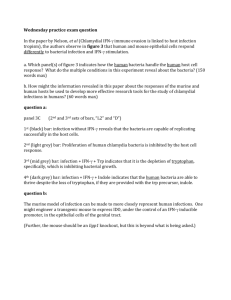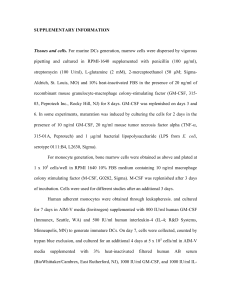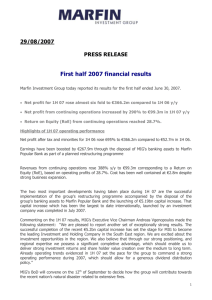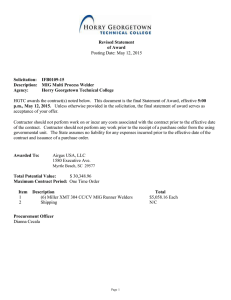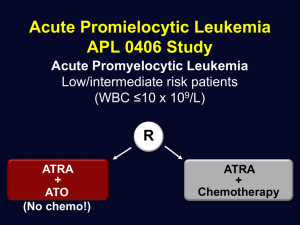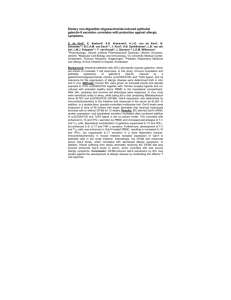Synthesis of -Chemokines IP-10, I-TAC, and MIG Are Differentially
advertisement
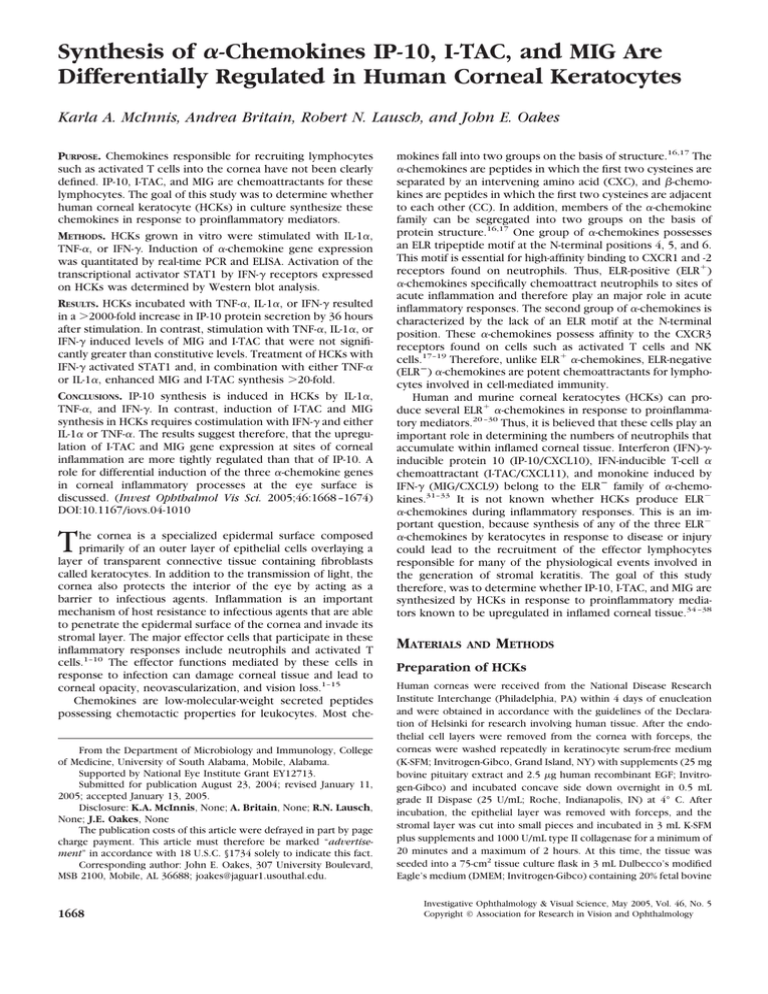
Synthesis of ␣-Chemokines IP-10, I-TAC, and MIG Are Differentially Regulated in Human Corneal Keratocytes Karla A. McInnis, Andrea Britain, Robert N. Lausch, and John E. Oakes PURPOSE. Chemokines responsible for recruiting lymphocytes such as activated T cells into the cornea have not been clearly defined. IP-10, I-TAC, and MIG are chemoattractants for these lymphocytes. The goal of this study was to determine whether human corneal keratocyte (HCKs) in culture synthesize these chemokines in response to proinflammatory mediators. METHODS. HCKs grown in vitro were stimulated with IL-1␣, TNF-␣, or IFN-␥. Induction of ␣-chemokine gene expression was quantitated by real-time PCR and ELISA. Activation of the transcriptional activator STAT1 by IFN-␥ receptors expressed on HCKs was determined by Western blot analysis. RESULTS. HCKs incubated with TNF-␣, IL-1␣, or IFN-␥ resulted in a ⬎2000-fold increase in IP-10 protein secretion by 36 hours after stimulation. In contrast, stimulation with TNF-␣, IL-1␣, or IFN-␥ induced levels of MIG and I-TAC that were not significantly greater than constitutive levels. Treatment of HCKs with IFN-␥ activated STAT1 and, in combination with either TNF-␣ or IL-1␣, enhanced MIG and I-TAC synthesis ⬎20-fold. CONCLUSIONS. IP-10 synthesis is induced in HCKs by IL-1␣, TNF-␣, and IFN-␥. In contrast, induction of I-TAC and MIG synthesis in HCKs requires costimulation with IFN-␥ and either IL-1␣ or TNF-␣. The results suggest therefore, that the upregulation of I-TAC and MIG gene expression at sites of corneal inflammation are more tightly regulated than that of IP-10. A role for differential induction of the three ␣-chemokine genes in corneal inflammatory processes at the eye surface is discussed. (Invest Ophthalmol Vis Sci. 2005;46:1668 –1674) DOI:10.1167/iovs.04-1010 T he cornea is a specialized epidermal surface composed primarily of an outer layer of epithelial cells overlaying a layer of transparent connective tissue containing fibroblasts called keratocytes. In addition to the transmission of light, the cornea also protects the interior of the eye by acting as a barrier to infectious agents. Inflammation is an important mechanism of host resistance to infectious agents that are able to penetrate the epidermal surface of the cornea and invade its stromal layer. The major effector cells that participate in these inflammatory responses include neutrophils and activated T cells.1–10 The effector functions mediated by these cells in response to infection can damage corneal tissue and lead to corneal opacity, neovascularization, and vision loss.1–15 Chemokines are low-molecular-weight secreted peptides possessing chemotactic properties for leukocytes. Most cheFrom the Department of Microbiology and Immunology, College of Medicine, University of South Alabama, Mobile, Alabama. Supported by National Eye Institute Grant EY12713. Submitted for publication August 23, 2004; revised January 11, 2005; accepted January 13, 2005. Disclosure: K.A. McInnis, None; A. Britain, None; R.N. Lausch, None; J.E. Oakes, None The publication costs of this article were defrayed in part by page charge payment. This article must therefore be marked “advertisement” in accordance with 18 U.S.C. §1734 solely to indicate this fact. Corresponding author: John E. Oakes, 307 University Boulevard, MSB 2100, Mobile, AL 36688; joakes@jaguar1.usouthal.edu. 1668 mokines fall into two groups on the basis of structure.16,17 The ␣-chemokines are peptides in which the first two cysteines are separated by an intervening amino acid (CXC), and -chemokines are peptides in which the first two cysteines are adjacent to each other (CC). In addition, members of the ␣-chemokine family can be segregated into two groups on the basis of protein structure.16,17 One group of ␣-chemokines possesses an ELR tripeptide motif at the N-terminal positions 4, 5, and 6. This motif is essential for high-affinity binding to CXCR1 and -2 receptors found on neutrophils. Thus, ELR-positive (ELR⫹) ␣-chemokines specifically chemoattract neutrophils to sites of acute inflammation and therefore play an major role in acute inflammatory responses. The second group of ␣-chemokines is characterized by the lack of an ELR motif at the N-terminal position. These ␣-chemokines possess affinity to the CXCR3 receptors found on cells such as activated T cells and NK cells.17–19 Therefore, unlike ELR⫹ ␣-chemokines, ELR-negative (ELRⴚ) ␣-chemokines are potent chemoattractants for lymphocytes involved in cell-mediated immunity. Human and murine corneal keratocytes (HCKs) can produce several ELR⫹ ␣-chemokines in response to proinflammatory mediators.20 –30 Thus, it is believed that these cells play an important role in determining the numbers of neutrophils that accumulate within inflamed corneal tissue. Interferon (IFN)-␥inducible protein 10 (IP-10/CXCL10), IFN-inducible T-cell ␣ chemoattractant (I-TAC/CXCL11), and monokine induced by IFN-␥ (MIG/CXCL9) belong to the ELRⴚ family of ␣-chemokines.31–33 It is not known whether HCKs produce ELR⫺ ␣-chemokines during inflammatory responses. This is an important question, because synthesis of any of the three ELR⫺ ␣-chemokines by keratocytes in response to disease or injury could lead to the recruitment of the effector lymphocytes responsible for many of the physiological events involved in the generation of stromal keratitis. The goal of this study therefore, was to determine whether IP-10, I-TAC, and MIG are synthesized by HCKs in response to proinflammatory mediators known to be upregulated in inflamed corneal tissue.34 –38 MATERIALS AND METHODS Preparation of HCKs Human corneas were received from the National Disease Research Institute Interchange (Philadelphia, PA) within 4 days of enucleation and were obtained in accordance with the guidelines of the Declaration of Helsinki for research involving human tissue. After the endothelial cell layers were removed from the cornea with forceps, the corneas were washed repeatedly in keratinocyte serum-free medium (K-SFM; Invitrogen-Gibco, Grand Island, NY) with supplements (25 mg bovine pituitary extract and 2.5 g human recombinant EGF; Invitrogen-Gibco) and incubated concave side down overnight in 0.5 mL grade II Dispase (25 U/mL; Roche, Indianapolis, IN) at 4° C. After incubation, the epithelial layer was removed with forceps, and the stromal layer was cut into small pieces and incubated in 3 mL K-SFM plus supplements and 1000 U/mL type II collagenase for a minimum of 20 minutes and a maximum of 2 hours. At this time, the tissue was seeded into a 75-cm2 tissue culture flask in 3 mL Dulbecco’s modified Eagle’s medium (DMEM; Invitrogen-Gibco) containing 20% fetal bovine Investigative Ophthalmology & Visual Science, May 2005, Vol. 46, No. 5 Copyright © Association for Research in Vision and Ophthalmology IOVS, May 2005, Vol. 46, No. 5 Synthesis of ␣-Chemokines in Human Corneal Keratocytes serum, 1⫻ antibiotic-antimycotic (Invitrogen-Gibco), 10 mM HEPES, 1.5% sodium bicarbonate (Invitrogen-Gibco), 0.004 N sodium hydroxide, and 0.2 g/mL kanamycin (Sigma-Aldrich, St. Louis, MO). Once the cells reached confluence, they were harvested and seeded into 25-cm2 flasks in DMEM containing 10% fetal bovine serum. At 80% confluence, the medium was then replaced daily with SFM (Opti-MEM I; InvitrogenGibco) supplemented with 5 g/mL gentamicin (Invitrogen-Gibco). After 3 days, the medium was replaced with 2.0 mL SFM containing selected concentrations of either human recombinant interleukin (IL)-1␣ (R&D Systems, Inc., Minneapolis, MN), human recombinant tumor necrosis factor (TNF)-␣ (Genzyme, Cambridge, MA), or human recombinant IFN-␥ (PBL Biomedical Laboratories, New Brunswick, NJ). Supernatants were then collected from cultures at selected times after stimulation and analyzed for human IP-10, MIG, and I-TAC with ELISA kits (R&D Systems, Inc.). Synergy was determined by treating the HCKs with select combinations of TNF-␣ and IFN-␥ or IL-1␣, and IFN-␥ and comparing the results with single cytokine treatment. Minimum levels of detection were as follows: hIP-10, 1.67 pg/mL; hMIG, 3.84 pg/mL; and hI-TAC, 13.9 pg/mL). Results were read on a microplate reader (MRX; Dynatech Laboratories, Chantilly, VA) at 450 and 550 nm. A small paired t-test was used to calculate significant differences between chemokine levels. Analysis of mRNA Levels by Real-Time PCR Total cellular RNA was extracted from cell cultures by the acid guanidium thiocyanate-phenol-chloroform method, as described previously.23 RNA was then converted into cDNA with an RNA PCR core kit (GeneAmp; Applied Biosystems/Roche, Branchburg, NJ) according to the manufacturer’s instructions. The DNA was then amplified by realtime PCR performed on a PCR thermocycler (iCycler iQ Multi-Color Real Time PCR Detection System; Bio-Rad, Hercules, CA). Primers were selected by computer (Beacon Designer v.2.13 software; Premier Biosoft, Palo Alto, CA) and then analyzed by BLAST (www.ncbi.nlm.nih. gov/blast/ provided in the public domain by the National Center for Biotechnology Information, Bethesda, MD) to ensure that the primers were specific and thus amplified only the gene of interest during PCR. The primer sequences chosen were human IP-10 primers: mRNA forward oligonucleotide 5⬘-CTTCCAAGGATGGACCACACA-3⬘ and mRNA reverse oligonucleotide 5⬘-CCTTCCTACAGGAGTAGTAGCAG3⬘; and human GAPD primers: mRNA forward oligonucleotide 5⬘GAAGGTGAAGGTCGGAGTC-3⬘; and mRNA reverse oligonucleotide 5⬘-GAAGATGGTGATGGGATTTC-3⬘. 1669 IFN-␥ receptor mRNA. RT-PCR products were analyzed by adding equal volumes (15 L) of the PCR-amplified product to individual lanes of a 1.5% agarose gel containing 0.5 g/mL ethidium bromide. Electrophoresis was then performed at 100 V in 1⫻ Tris-acetate-EDTA (TAE) electrophoresis buffer containing 0.1 g/mL ethidium bromide. The gel was then viewed with a transilluminator and the image captured with a zoom digital camera (Digital Science DC120; Eastman Kodak Co., Rochester, NY). The RT-PCR band intensities were analyzed with the accompanying software (ID Image Analysis Software for Windows ver. 2.0.3; Eastman Kodak Co.). The constitutively expressed gene GAPD served as the positive RT-PCR control to ensure that each experimental sample contained equal amounts of purified mRNA. Western Blot Analysis After incubation for 3 days in KSFM, total protein extracts were prepared by aspirating the medium and washing cells with ice-cold PBS. The cells were then scraped and pelleted in a 1.5 mL microcentrifuge tube. They were then resuspended in 100 L SDS lysis buffer (200 mM Tris-HCl [pH 6.8], 15% glycerol, 4% SDS, and 6% -mercaptoethanol) and pipetted vigorously to lyse the cells. Cell lysates were stored at ⫺70°C until use. For Western blot analysis experiments, 20 L of total protein extracts was boiled for 3 minutes in the SDS lysis buffer and separated on a 10% Tris-glycine gel (Novex, San Diego, CA) with SDS running buffer (25 mM Tris-base, 190 mM glycine, and 0.1% SDS). The contents of the gel were then transferred to a polyvinylidene difluoride (PVDF) membrane (Invitrogen) with a transfer apparatus (Western Transfer Apparatus; Novex). Membranes were then blocked with 6% nonfat dry milk in TBS-T (Tris-buffered saline ⫹ 0.1% Tween) for 1 hour. The membrane was then washed with TBS-T and incubated overnight with anti-STAT1 (M-22), anti-p-STAT1 (Tyr 701), or anti--actin (C-11; Santa Cruz Biotechnology, Santa Cruz, CA) at room temperature in TBS-T with 0.5% BSA. Blots were washed three times with TBS-T and TBS and then incubated with the corresponding horseradish-peroxidase (HRP)– conjugated secondary antibody (␣-rabbit-HRP; Pierce, Rockford, IL; ␣-goat-HRP, Sigma-Aldrich) for 2 hours in TBS-T with 0.5% BSA. The blot was then washed as just described and immunoblot signals detected with chemiluminescent substrate (Super Signal West Dura Extended Duration Substrate; Pierce). RESULTS Reverse Transcription–Polymerase Chain Reaction IP-10, I-TAC, and MIG Synthesis in HCKs after Stimulation with IL-1␣ and TNF-␣ Total RNA was extracted and analyzed for the presence of IFN-␥ receptor mRNA by RT-PCR as previously reported.23 Primers were selected with the program Primer Quest (purchased from IDT, Coralville, IA, at http://www.idtdna.com) and analyzed with BLAST. The primer sequences selected and the expected RT-PCR product size are as follows: human IFN-␥ receptor primers (mRNA 321-bp product): mRNA forward oligonucleotide 5⬘-CCAAGTCCTTGATCTCTGTGG-3⬘; and mRNA reverse oligonucleotide 5⬘-CTGCCAGGTTCAGACTGGTT3⬘; and human GAPD primers (mRNA 417-bp product): mRNA forward oligonucleotide 5⬘-CCAAAGGGTCATCATCTCTGC-3⬘; mRNA reverse oligonucleotide 5⬘-ATTTGGCAGGTTTTTCTAGACGG-3⬘. For the PCR reaction, a master mix containing DNA polymerase (AmpliTaq; Applied Biosystems/Roche) and appropriate primers was prepared according to the manufacturer’s instructions. Twelve-microliter aliquots were then dispersed into PCR tubes along with 3 L cDNA, for a total volume of 15 L. RT-PCR products were amplified using an initial thermocycle of 2 minutes at 95°C followed by thermocycles of 30 seconds at 95°C, 30 seconds at 65°C, and 2 minutes at 72°C. Preliminary experiments established that 20 to 22 cycles of amplification were within the exponential amplification phase of GAPD, whereas 28 cycles of amplification were needed to amplify detectable levels of Previous studies in our laboratory have shown that HCKs produce maximum levels of ELR⫹ ␣-chemokines in response to 1000 U/mL of IL-1␣ or 500 U/mL of TNF-␣.23–25,30 Therefore, preliminary experiments were performed to determine whether IP-10, I-TAC, and MIG expression could be induced in HCKs in response to these doses of proinflammatory mediators. Over the course of 36 hours, supernatants were collected from HCKs stimulated with either IL-1␣ (1000 U/mL) or TNF-␣ (500 U/mL), and protein levels of IP-10, MIG, and I-TAC were analyzed by ELISA. It was found that TNF-␣ stimulation increased IP-10 expression ⬎15,000-fold, whereas IL-1␣ stimulation enhanced IP-10 expression ⬎3000-fold (Fig. 1A). IP-10 mRNA levels were also increased in IL-1␣- and TNF␣-stimulated cells by ⬎1000-fold, as determined by real-time PCR (Fig. 1B). Dose–response experiments demonstrated that IP-10 gene expression is responsive to concentrations of IL-1␣ and TNF-␣ as low as 5 U/mL (Fig. 1C). In contrast, IL-1␣ did not stimulate detectable synthesis of either MIG or I-TAC, whereas TNF-␣ stimulated low-picogram levels of MIG synthesis that were only detectable at 36 hours after stimulation (data not shown). 1670 McInnis et al. IOVS, May 2005, Vol. 46, No. 5 FIGURE 2. IFN-␥ receptor mRNA was constitutively expressed in HCKs. Total RNA was extracted from cells from two different donors and stimulated with 100 U/mL IFN-␥ or media alone for 18 hours. IFN-␥ receptor and GAPD mRNA levels were analyzed by RT-PCR. To determine whether HCKs express message for IFN-␥ receptors, RNA was extracted from HCKs and analyzed for the presence of receptor mRNA by RT-PCR. It was found that IFN-␥ receptor mRNA was constitutively expressed by HCKs (Fig. 2). Functional IFN-␥ receptors transduce a signal that leads to activation of STAT1 through tyrosine phosphorylation, inducing formation of STAT1:STAT1 homodimers.43,44 To determine whether the IFN-␥ receptors synthesized by HCKs are membrane bound and functional, cell cultures were treated with IFN-␥ at 100 U/mL for a period of 0.5 to 6 hours. Total protein extracts were then collected and analyzed by Western blot for the presence of phosphorylated STAT1 and total STAT1. -Actin served as the internal control (Fig. 3). Phosphorylation of STAT1 was detected as early as 30 minutes after stimulation (Fig. 3, lane 2). After reaching its peak at 1 hour after stimulation, levels of activated STAT1 began to decline until they were no longer detectable at 6 hours (Fig. 3, lanes 3– 6). These results suggest that the IFN-␥ receptors are expressed on the HCK membranes and are capable of responding to IFN-␥. To determine whether IFN-␥ activated receptors induce IP-10, I-TAC, and MIG synthesis, production of the three ␣-chemokines was analyzed in HCKs after stimulation with increas- FIGURE 1. IP-10 protein synthesis and intracellular IP-10 mRNA levels in HCKs stimulated with IL-1␣ or TNF-␣. (A) Cells were stimulated with either 1000 U/mL IL-1␣ or 500 U/mL TNF-␣ for 36 hours. Culture supernatants were harvested at the time indicated, and IP-10 levels were quantitated by ELISA. (B) Total RNA was isolated from the cultures, and intracellular mRNA levels were analyzed by real-time PCR and calculated as the increase (x-fold) over media treated samples. (C) Supernatants were collected from cells treated with increasing concentrations (5, 10, 20, 30, 50, and 100 U/mL) of TNF-␣ or IL-1␣ for 18 hours and assayed for IP-10 by ELISA. Quantitative results for four donors are shown as mean ⫾ SEM (*P ⬍ 0.05). IP-10, I-TAC, and MIG Synthesis in HCKs after Stimulation with IFN-␥ In many cell types, the genes encoding IP-10, I-TAC, and MIG are responsive to IFN-␥ stimulation.39 – 42 Because the presence of the IFN-␥ receptor on HCKs has not been firmly established, it was of interest to determine whether these cells possess IFN-␥ receptors and, if so, whether IFN-␥ has the capacity to induce synthesis of the three ␣-chemokines. FIGURE 3. IFN-␥ receptor was functionally capable of signal transduction in HCKs. Total protein was extracted from cells (two donors) that were stimulated with IFN-␥ (100 U/mL) for up to 6 hours or media alone (6 hours) and separated by gel electrophoresis. The gel was then blotted onto a PVDF membrane, which was probed for p-STAT1, total STAT1, or -actin. The proteins were visualized on a luminescent image analyzer (LAS-1000 Plus; Fuji, Tokyo, Japan). IOVS, May 2005, Vol. 46, No. 5 Synthesis of ␣-Chemokines in Human Corneal Keratocytes 1671 18 hours. This time point was selected because HCKs stimulated with IL-1␣, TNF-␣, or IFN-␥ for 18 hours failed to produce MIG or I-TAC. Therefore, if synthesis of either chemokine is induced in HCKs stimulated with combinations of inducers for 18 hours, the results would suggest that synergy was involved in the induction. Figure 5 shows that HCKs stimulated with combinations of either IFN-␥ and IL-1␣ or IFN-␥ and TNF-␣ produced ⬍1500 pg of MIG (Fig. 5A) and ⬎500 pg of I-TAC (Fig. 5B). These levels were ⬎24 times higher that those obtained when HCKs were individually induced with IL-1␣, TNF-␣, or IFN-␥ alone or with combinations of IL-1␣ and TNF-␣. We also tested whether IP-10 synthesis could be synergistically enhanced after exposure to a combination of cytokines. It was found that when HCKs were exposed to IL-1␣ (10 and 20 U/mL) and TNF-␣ (10 and 20 U/mL) in combination with IFN-␥ (10 and 20 U/mL), the levels of IP-10 produced were enhanced more than fourfold above that obtained with a single stimulant (Fig. 6). In contrast, treatment of HCKs with a combination of IL-1␣ and TNF-␣ did not synergistically enhance IP-10 synthesis. These results demonstrate that cytokine combinations containing IFN-␥ elevate IP-10 gene expression. FIGURE 4. Dose–response curve and kinetics for IP-10 synthesis in HCKs stimulated with IFN-␥. (A) Supernatants were collected from cells stimulated with increasing concentrations (5, 10, 20, 30, 50, and 100 U/mL) of IFN-␥ for 18 hours. Supernatants were then assayed for IP-10, MIG, and I-TAC by ELISA. (B) Supernatants were collected from HCKs stimulated with IFN-␥ (100 U/mL) over a 36-hour period and analyzed for IP-10 by ELISA. Quantitative results for at least two donors are shown as the mean ⫾ SEM (*P ⬍ 0.05). ing doses of IFN-␥ (Fig. 4). In cell cultures receiving media only, IP-10, I-TAC, and MIG synthesis was below the level of detection. When treated with IFN-␥ (100 U/mL), HCKs produced ⬎400 pg of IP-10 (Fig. 4A). In contrast, neither the MIG nor I-TAC level was increased significantly after IFN-␥ stimulation when compared with HCKs treated with media alone. We also performed kinetic studies to determine the levels of IP-10 produced by HCKs, in response to IFN-␥ over a 36-hour period. IP-10 was secreted at levels ⬎2000-fold higher than untreated cells (Fig. 4B). These results indicate that HCKs exposed to IFN-␥ produce an increased amount of IP-10 but little to no MIG or I-TAC. I-TAC and MIG Synthesis in HCKs Stimulated with IFN-␥ and IL-1␣ or IFN-␥ and TNF-␣ Both IL-1␣ and TNF-␣ can synergize with IFN-␥ to enhance I-TAC and MIG gene expression in human astrocytes and neutrophils.40,41 Therefore, we tested whether costimulation would provide a stimulus strong enough to induce synthesis of these ELRⴚ ␣-chemokines. MIG and I-TAC synthesis was determined in cells stimulated with combinations of cytokines for FIGURE 5. Combinations of IFN-␥ and IL-1␣ or IFN-␥ and TNF-␣ increase MIG and I-TAC production by HCKs. Cells were stimulated with combinations of IFN-␥, TNF-␣, and IL-1␣ at 10 or 20 U/mL for 18 hours. Supernatants were then collected and assayed for MIG (A) and I-TAC (B) by ELISA. Quantitative results for three donors are shown as the mean ⫾ SEM (*P ⬍ 0.05). 1672 McInnis et al. FIGURE 6. Combinations of IFN-␥ and TNF-␣ or IFN-␥ and IL-1␣ increase IP-10 production in HCKs. Cells were stimulated with combinations of IFN-␥, TNF-␣, and IL-1␣ at 10 or 20 U/mL for 18 hours. Supernatants were then collected and assayed for IP-10 by ELISA. Quantitative results for three donors are shown as the mean ⫾ SEM (*P ⬍ 0.05). DISCUSSION IL-1␣ and TNF-␣ induce gene expression by activating the cytoplasmic transcriptional activator NF-B,45,46 whereas IFN-␥ induces gene expression by activating the cytoplasmic transcriptional factor STAT1.43,44 Because the promoters upstream of the genes for IP-10, MIG, and I-TAC all possess binding sites for NF-B and STAT1, one would expect that expression of all three genes would be inducible by IL-1␣, TNF-␣, and IFN-␥ stimulation. This hypothesis is supported by the fact that the three inducers can individually upregulate IP-10, I-TAC, and MIG gene expression in selected cell types and strains, such as astrocytes, neutrophils, and NIH 3T3 cells.39 – 41 Therefore, the unexpected finding in this study was that IL-1␣, TNF-␣, and IFN-␥ stimulated HCKs to synthesize nanogram levels of IP-10 but little I-TAC or MIG. It is not known why IP-10 is differentially upregulated in HCKs. One possible explanation is that the number and arrangements of NF-B and STAT1 binding motifs on the three promoters are not identical.33,47,48 For DNA bound transcriptional activators to upregulate gene expression, they must interact with several cotranscriptional factors that act as a bridge between the activator and the transcriptional apparatus bound to the transcriptional start site.49 –51 Therefore, it is possible that the mix of cotranscriptional factors produced by HCKs are more efficient at interacting with NF-B and STAT1 complexes bound to IP-10 promoters than to the promoters of the I-TAC and MIG genes. We also observed that IP-10 protein levels increased in a time-dependent manner even though expression of IP-10 mRNA remained almost constant after 12 hours. One possible explanation is that sustained stimulation of HCKs with chemokine inducers enhances the efficiency of IP-10 mRNA translation.52 A second observation made in the kinetic studies of IP-10 synthesis was that while all three cytokines induced IP-10 synthesis, the secreted levels of IP-10 were higher in cells treated with TNF-␣ (⬎11-fold) and IL-1␣ (⬎3.5-fold) than those in IFN-␥–treated cells. It is quite possible that TNF-␣- and IOVS, May 2005, Vol. 46, No. 5 IL-1␣-activated NF-B enhances transcription more efficiently than IFN-␥-activated STAT1. We further observed that, whereas HCKs exposed to a single cytokine did not produce significant levels of I-TAC and MIG, both were produced at levels ranging from 250 picograms to ⬎1 ng when HCKs were costimulated with IFN-␥ preparations containing either IL-1␣ or TNF-␣. Because both the I-TAC and MIG promoters possess a STAT1 binding site in addition to a NF-B binding site, these results suggest that I-TAC and MIG gene expression can only be activated in HCKs after the promoters of the two genes have interacted with both NF-B and STAT1.33,53,54 In addition to I-TAC and MIG, the levels of IP-10 produced by IL-1␣- and TNF-␣-stimulated HCKs were also significantly enhanced when IFN-␥ was added into the IL-1␣ or TNF-␣ preparations used to stimulate the cells. These results are probably attributable to the fact that cobinding of NF-B and STAT1 transcriptional activators to the IP-10 promoter also significantly enhances expression of this ELRⴚ ␣-chemokine gene. IL-1␣ and TNF-␣ are the primary proinflammatory cytokines released into corneal tissue at sites of injury or disease.34 –38 These proinflammatory mediators activate synthesis of a number of ELR⫹ ␣-chemokines that play an important role in chemoattracting neutrophils into sites of inflammation.20 –25,30 It is interesting that the only ELR⫺ ␣-chemokine produced by IL-1␣- and TNF-␣-stimulated HCKs is IP-10. This finding has potential physiological relevance. Corneal epithelial cells store physiologically active IL-1␣.36,55,56 After damage to the epithelial cell membrane, IL-1␣ can be immediately released into corneal extracellular spaces. Based on the results of this study, one can speculate that IP-10 is produced in diseased or injured corneal tissue before I-TAC and MIG. One activity that IP-10 possesses is the capacity to enhance binding of activated T cells to endothelial cells lining the walls of blood vessels.57 Thus, one in vivo function of the IP-10 produced by HCKs in response to IL-1␣ may be to enhance extravasation of activated T cells from blood vessels located in limbal areas of the cornea. In contrast to IP-10, the synthesis of I-TAC and MIG by HCKs require costimulation with IFN-␥. Because IFN-␥-producing cells are predominantly lymphocytes,58 synthesis of I-TAC and MIG may not occur within inflamed corneal tissue until IFN-␥producing lymphocytes have infiltrated the site of inflammation. In conclusion, it has been found that HCKs can synthesize the three ELRⴚ ␣-chemokines essential in chemoattracting activated T-cell subsets to sites of inflammation. It has been reported that HCKs influence the intensity of innate immune responses generated in stromal layers of the cornea by producing multiple ELR⫹ ␣-chemokines.23–25,30 The results of this study suggest that the ELRⴚ ␣-chemokines produced by HCKs may also play an important role in regulating acquired immune responses. References 1. Hazlett LD. Pathogenic mechanisms of P. aeruginosa keratitis: a review of the role of T cells, Langerhans cells, PMN, and cytokines. DNA Cell Biol. 2002;21:383–390. 2. Pearlman E, Heinzel FP, Hazlett FE Jr, Kazura JW. IL-12 modulation of T helper responses to the filarial helminth, Brugia malayi. J Immunol. 1995;154:4658 – 4664. 3. Hall LR, Kaifi JT, Diaconu E, Pearlman E. CD4(⫹) depletion selectively inhibits eosinophil recruitment to the cornea and abrogates Onchocerca volvulus keratitis (River blindness). Infect Immun. 2000;68:5459 –5461. 4. Doymaz MZ, Rouse BT. Herpetic stromal keratitis: an immunopathologic disease mediated by CD4⫹ T lymphocytes. Invest Ophthalmol Vis Sci. 1992;33:2165–2173. IOVS, May 2005, Vol. 46, No. 5 Synthesis of ␣-Chemokines in Human Corneal Keratocytes 5. Gangappa S, Deshpande SP, Rouse BT. Bystander activation of CD4(⫹) T cells can represent an exclusive means of immunopathology in a virus infection. Eur J Immunol. 1999;29:3674 –3682. 6. Niederkorn JY. The immunology of corneal transplantation. Dev Ophthalmol. 1999;30:129 –140. 7. Kumaraguru U, Davis I, Rouse BT. Chemokines and ocular pathology caused by corneal infection with herpes simplex virus. J Neurovirol. 1999;5:42– 47. 8. Yan XT, Tumpey TM, Kunkel SL, Oakes JE, Lausch RN. Role of MIP-2 in neutrophil migration and tissue injury in the herpes simplex virus-1-infected cornea. Invest Ophthalmol Vis Sci. 1998; 39:1854 –1862. 9. Thomas J, Gangappa S, Kanangat S, Rouse BT. On the essential involvement of neutrophils in the immunopathologic disease: herpetic stromal keratitis. J Immunol. 1997;158:1383–1391. 10. Kaifi JT, Diaconu E, Pearlman E. Distinct roles for PECAM-1, ICAM-1, and VCAM-1 in recruitment of neutrophils and eosinophils to the cornea in ocular onchocerciasis (river blindness). J Immunol. 2001;166:6795– 6801. 11. Klebanoff SJ. Myeloperoxidase. Proc Assoc Am Physicians. 1999; 111:383–389. 12. Grisham MB, Jefferson MM, Melton DF, Thomas EL. Chlorination of endogenous amines by isolated neutrophils: ammonia-dependent bactericidal, cytotoxic, and cytolytic activities of the chloramines. J Biol Chem. 1984;259:10404 –10413. 13. Thomas EL, Grisham MB, Melton DF, Jefferson MM. Evidence for a role of taurine in the in vitro oxidative toxicity of neutrophils toward erythrocytes. J Biol Chem. 1985;260:3321–3329. 14. Domigan NM, Charlton TS, Duncan MW, Winterbourn CC, Kettle AJ. Chlorination of tyrosyl residues in peptides by myeloperoxidase and human neutrophils. J Biol Chem. 1995;270:16542– 16548. 15. Pepose JS, Holland GN, Wilhelmus K. Ocular Infections and Immunity. St. Louis, MO: Mosby-Year Book; 1996. 16. Zlotnik A, Yoshie O. Chemokines: a new classification system and their role in immunity. Immunity. 2000;12:121–127. 17. Luster AD. Chemokines: chemotactic cytokines that mediate inflammation. N Engl J Med. 1998;338:436 – 445. 18. Murphy PM, Baggiolini M, Charo IF, et al. International union of pharmacology. XXII. Nomenclature for chemokine receptors. Pharmacol Rev. 2000;52:145–176. 19. Robertson MJ. Role of chemokines in the biology of natural killer cells. J Leukoc Biol. 2002;71:173–183. 20. Hong JW, Liu JJ, Lee JS, et al. Proinflammatory chemokine induction in keratocytes and inflammatory cell infiltration into the cornea. Invest Ophthalmol Vis Sci. 2001;42:2795–2803. 21. Mahajan VB, Wei C, McDonnell PJ III. Microarray analysis of corneal fibroblast gene expression after interleukin-1 treatment. Invest Ophthalmol Vis Sci. 2002;43:2143–2151. 22. Spandau UH, Toksoy A, Verhaart S, Gillitzer R, Kruse FE. High expression of chemokines Gro-alpha (CXCL-1), IL-8 (CXCL-8), and MCP-1 (CCL-2) in inflamed human corneas in vivo. Arch Ophthalmol. 2003;121:825– 831. 23. Fillmore RA, Nelson SE, Lausch RN, Oakes JE. Differential regulation of ENA-78 and GCP-2 gene expression in human corneal keratocytes and epithelial cells. Invest Ophthalmol Vis Sci. 2003; 44:3432–3437. 24. Tran MT, Ritchie MH, Lausch RN, Oakes JE. Calcitonin gene-related peptide induces IL-8 synthesis in human corneal epithelial cells. J Immunol. 2000;164:4307– 4312. 25. Cubitt CL, Tang Q, Monteiro CA, Lausch RN, Oakes JE. IL-8 gene expression in cultures of human corneal epithelial cells and keratocytes. Invest Ophthalmol Vis Sci. 1993;34:3199 –3206. 26. Kernacki KA, Goebel DJ, Poosch MS, Hazlett LD. Early cytokine and chemokine gene expression during Pseudomonas aeruginosa corneal infection in mice. Infect Immun. 1998;66:376 –379. 27. Xue ML, Thakur A, Lutze-Mann L, Willcox MD. Pro-inflammatory cytokine/chemokine gene expression in human corneal epithelial cells colonized by Pseudomonas aeruginosa. Clin Exp Ophthalmol. 2000;28:197–200. 1673 28. Yamagami S, Miyazaki D, Ono SJ, Dana MR. Differential chemokine gene expression in corneal transplant rejection. Invest Ophthalmol Vis Sci. 1999;40:2892–2897. 29. Tumpey TM, Cheng H, Yan XT, Oakes JE, Lausch RN. Chemokine synthesis in the HSV-1-infected cornea and its suppression by interleukin-10. J Leukoc Biol. 1998;63:486 – 492. 30. Cubitt CL, Lausch RN, Oakes JE. Differential induction of GRO alpha gene expression in human corneal epithelial cells and keratocytes exposed to proinflammatory cytokines. Invest Ophthalmol Vis Sci. 1997;38:1149 –1158. 31. Farber JM. Mig and IP-10: CXC chemokines that target lymphocytes. J Leukoc Biol. 1997;61:246 –257. 32. Loetscher M, Gerber B, Loetscher P, et al. Chemokine receptor specific for IP10 and mig: structure, function, and expression in activated T-lymphocytes. J Exp Med. 1996;184:963–969. 33. Tensen CP, Flier J, Rampersad SS, et al. Genomic organization, sequence and transcriptional regulation of the human CXCL 11(1) gene. Biochim Biophys Acta. 1999;1446:167–172. 34. Cole N, Bao S, Willcox M, Husband AJ. TNF-alpha production in the cornea in response to Pseudomonas aeruginosa challenge. Immunol Cell Biol. 1999;77:164 –166. 35. Elner VM, Strieter RM, Pavilack MA, et al. Human corneal interleukin-8. IL-1 and TNF-induced gene expression and secretion. Am J Pathol. 1991;139:977–988. 36. Wilson SE, He YG, Lloyd SA. EGF, EGF receptor, basic FGF, TGF beta-1, and IL-1 alpha mRNA in human corneal epithelial cells and stromal fibroblasts. Invest Ophthalmol Vis Sci. 1992;33:1756 – 1765. 37. Shams NB, Sigel MM, Davis RM. Interferon-gamma, Staphylococcus aureus, and lipopolysaccharide/silica enhance interleukin-1 beta production by human corneal cells. Reg Immunol. 1989;2:136 –148. 38. Planck SR, Huang XN, Robertson JE, Rosenbaum JT. Cytokine mRNA levels in rat ocular tissues after systemic endotoxin treatment. Invest Ophthalmol Vis Sci. 1994;35:924 –930. 39. Majumder S, Zhou LZ, Chaturvedi P, Babcock G, Aras S, Ransohoff RM. Regulation of human IP-10 gene expression in astrocytoma cells by inflammatory cytokines. J Neurosci Res. 1998;54:169 –180. 40. Cole KE, Strick CA, Paradis TJ, et al. Interferon-inducible T cell alpha chemoattractant (I-TAC): a novel non-ELR CXC chemokine with potent activity on activated T cells through selective high affinity binding to CXCR3. J Exp Med. 1998;187:2009 –2021. 41. Gasperini S, Marchi M, Calzetti F, et al. Gene expression and production of the monokine induced by IFN-gamma (MIG), IFNinducible T cell alpha chemoattractant (I-TAC), and IFN-gammainducible protein-10 (IP-10) chemokines by human neutrophils. J Immunol. 1999;162:4928 – 4937. 42. Soejima K, Rollins BJ. A functional IFN-gamma-inducible protein10/CXCL10-specific receptor expressed by epithelial and endothelial cells that is neither CXCR3 nor glycosaminoglycan. J Immunol. 2001;167:6576 – 6582. 43. Aaronson DS, Horvath CM. A road map for those who don’t know JAK-STAT. Science. 2002;296:1653–1655. 44. Darnell JE Jr, Kerr IM, Stark GR. Jak-STAT pathways and transcriptional activation in response to IFNs and other extracellular signaling proteins. Science. 1994;264:1415–1421. 45. Ghosh S, May MJ, Kopp EB. NF-B and Rel proteins: evolutionarily conserved mediators of immune responses. Annu Rev Immunol. 1998;16:225–260. 46. Li Q, Verma IM. NF-kappaB regulation in the immune system. Nat Rev Immunol. 2002;2:725–734. 47. Luster AD, Ravetch JV. Genomic characterization of a gammainterferon-inducible gene (IP-10) and identification of an interferoninducible hypersensitive site. Mol Cell Biol. 1987;7:3723–3731. 48. Wright TM, Farber JM. 5⬘ regulatory region of a novel cytokine gene mediates selective activation by interferon gamma. J Exp Med. 1991;173:417– 422. 49. Lemon B, Tjian R. Orchestrated response: a symphony of transcription factors for gene control. Genes Dev. 2000;14:2551–2569. 50. Sheppard KA, Rose DW, Haque ZK, et al. Transcriptional activation by NF-kappaB requires multiple coactivators. Mol Cell Biol. 1999;19:6367– 6378. 1674 McInnis et al. 51. Yamit-Hezi A, Nir S, Wolstein O, Dikstein R. Interaction of TAFII105 with selected p65/RelA dimers is associated with activation of subset of NF-kappa B genes. J Biol Chem. 2000;275:18180 – 18187. 52. Han J, Brown T, Beutler B. Endotoxin-responsive sequences control cachectin/tumor necrosis factor biosynthesis at the translational level. J Exp Med. 1990;171:465– 475. 53. Decker T, Kovarik P, Meinke A. GAS elements: a few nucleotides with a major impact on cytokine-induced gene expression. J Interferon Cytokine Res. 1997;17:121–134. 54. Wong P, Severns CW, Guyer NB, Wright TM. A unique palindromic element mediates gamma interferon induction of mig gene expression. Mol Cell Biol. 1994;14:914 –922. IOVS, May 2005, Vol. 46, No. 5 55. Gahring LC, Buckley A, Daynes RA. Presence of epidermal-derived thymocyte activating factor/interleukin 1 in normal human stratum corneum. J Clin Invest. 1985;76:1585–1591. 56. Tran MT, Dean DA, Lausch RN, Oakes JE. Membranes of herpes simplex virus type-1-infected human corneal epithelial cells are not permeabilized to macromolecules and therefore do not release IL-1␣. Virology. 1998;244:74 –78. 57. Taub DD, Lloyd AR, Conlon K, et al. Recombinant human interferon-inducible protein 10 is a chemoattractant for human monocytes and T lymphocytes and promotes T cell adhesion to endothelial cells. J Exp Med. 1993;177:1809 –1814. 58. Janeway CA, Travers P, Walport M, Shlomchik MJ. Immunobiology: The Immune System in Health and Disease. New York: Garland Publishing; 2001.
